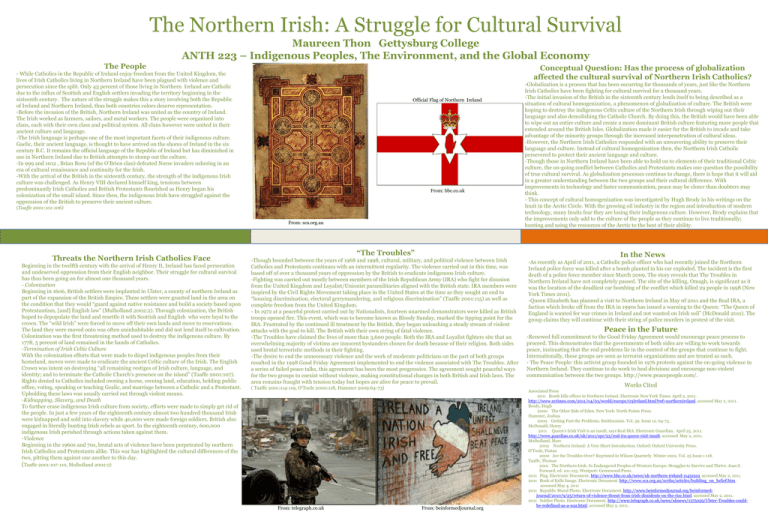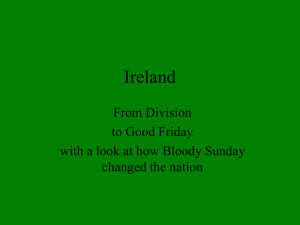Thon poster - Gettysburg College
advertisement

The Northern Irish: A Struggle for Cultural Survival Maureen Thon Gettysburg College ANTH 223 – Indigenous Peoples, The Environment, and the Global Economy The People Conceptual Question: Has the process of globalization affected the cultural survival of Northern Irish Catholics? - While Catholics in the Republic of Ireland enjoy freedom from the United Kingdom, the lives of Irish Catholics living in Northern Ireland have been plagued with violence and persecution since the split. Only 43 percent of those living in Northern Ireland are Catholic due to the influx of Scottish and English settlers invading the territory beginning in the sixteenth century. The nature of the struggle makes this a story involving both the Republic of Ireland and Northern Ireland, thus both countries colors deserve representation. -Before the invasion of the British, Northern Ireland was united as the country of Ireland. The Irish worked as farmers, sailors, and metal workers. The people were organized into clans, each with their own class and political system. All clans however were united in their ancient culture and language. -The Irish language is perhaps one of the most important facets of their indigenous culture. Gaelic, their ancient language, is thought to have arrived on the shores of Ireland in the six century B.C. It remains the official language of the Republic of Ireland but has diminished in use in Northern Ireland due to British attempts to stomp out the culture. -In 999 and 1012 , Brian Boru (of the O’Brien clan) defeated Norse invaders ushering in an era of cultural renaissance and continuity for the Irish. -With the arrival of the British in the sixteenth century, the strength of the indigenous Irish culture was challenged. As Henry VIII declared himself king, tensions between predominantly Irish Catholics and British Protestants flourished as Henry began his colonization of the small island. Since then, the indigenous Irish have struggled against the oppression of the British to preserve their ancient culture. Official Flag of Northern Ireland From: bbc.co.uk (Taaffe 2001:101-106) From: sca.org.au Threats the Northern Irish Catholics Face Beginning in the twelfth century with the arrival of Henry II, Ireland has faced persecution and undeserved oppression from their English neighbor. Their struggle for cultural survival has thus been going on for almost one thousand years. - Colonization Beginning in 1606, British settlers were implanted in Ulster, a county of northern Ireland as part of the expansion of the British Empire. These settlers were granted land in the area on the condition that they would “guard against native resistance and build a society based upon Protestantism, [and] English law” (Mulholland 2002:2). Through colonization, the British hoped to depopulate the land and resettle it with Scottish and English who were loyal to the crown. The “wild Irish” were forced to move off their own lands and move to reservations. The land they were moved onto was often uninhabitable and did not lend itself to cultivation. Colonization was the first threatening method used to destroy the indigenous culture. By 1778, 5 percent of land remained in the hands of Catholics. -Termination of Irish Celtic Culture With the colonization efforts that were made to dispel indigenous peoples from their homeland, moves were made to eradicate the ancient Celtic culture of the Irish. The English Crown was intent on destroying “all remaining vestiges of Irish culture, language, and identity; and to terminate the Catholic Church’s presence on the island” (Taaffe 2001:107). Rights denied to Catholics included owning a horse, owning land, education, holding public office, voting, speaking or teaching Gealic, and marriage between a Catholic and a Protestant. Upholding these laws was usually carried out through violent means. -Kidnapping, Slavery, and Death To further erase indigenous Irish culture from society, efforts were made to simply get rid of the people. In just a few years of the eighteenth century almost two hundred thousand Irish were kidnapped and sold into slavery while 40,000 were made foreign soldiers. British also engaged in literally hunting Irish rebels as sport. In the eighteenth century, 600,000 indigenous Irish perished through actions taken against them. -Violence Beginning in the 1960s and 70s, brutal acts of violence have been perpetrated by northern Irish Catholics and Protestants alike. This war has highlighted the cultural differences of the two, pitting them against one another to this day. “The Troubles” -Though bounded between the years of 1968 and 1998, cultural, military, and political violence between Irish Catholics and Protestants continues with an intermittent regularity. The violence carried out in this time, was based off of over a thousand years of oppression by the British to eradicate indigenous Irish culture. -Fighting was carried out mostly between members of the Irish Republican Army (IRA) who fight for disunion from the United Kingdom and Loyalist/Unionist paramilitaries aligned with the British state. IRA members were inspired by the Civil Rights Movement taking place in the United States at the time as they sought an end to “housing discrimination, electoral gerrymandering, and religious discrimination” (Taaffe 2001:115) as well as complete freedom from the United Kingdom. - In 1972 at a peaceful protest carried out by Nationalists, fourteen unarmed demonstrators were killed as British troops opened fire. This event, which was to become known as Bloody Sunday, marked the tipping point for the IRA. Frustrated by the continued ill treatment by the British, they began unleashing a steady stream of violent attacks with the goal to kill. The British with their own string of fatal violence. -The Troubles have claimed the lives of more than 3,600 people. Both the IRA and Loyalist fighters site that an overwhelming majority of victims are innocent bystanders chosen for death because of their religion. Both sides used brutal terroristic methods in their fighting. -The desire to end the unnecessary violence and the work of moderate politicians on the part of both groups resulted in the 1998 Good Friday Agreement implemented to end the violence associated with The Troubles. After a series of failed peace talks, this agreement has been the most progressive. The agreement sought peaceful ways for the two groups to coexist without violence, making constitutional changes in both British and Irish laws. The area remains fraught with tension today but hopes are alive for peace to prevail. ( Taaffe 2001:114-119, O’Toole 2000:118, Hammer 2009:64-73) (Taaffe 2001:107-110, Mulholland 2002:2) From: telegraph.co.uk From: beinformedjournal.org -Globalization is a process that has been occurring for thousands of years, just like the Northern Irish Catholics have been fighting for cultural survival for a thousand years. -The initial invasion of the British in the sixteenth century lends itself to being described as a situation of cultural homogenization, a phenomenon of globalization of culture. The British were hoping to destroy the indigenous Celtic culture of the Northern Irish through wiping out their language and also demolishing the Catholic Church. By doing this, the British would have been able to wipe out an entire culture and create a more dominant British culture featuring more people that extended around the British Isles. Globalization made it easier for the British to invade and take advantage of the minority groups through the increased interpenetration of cultural ideas. -However, the Northern Irish Catholics responded with an unwavering ability to preserve their language and culture. Instead of cultural homogenization then, the Northern Irish Catholic persevered to protect their ancient language and culture. -Though those in Northern Ireland have been able to hold on to elements of their traditional Celtic culture, the on-going conflict between Catholics and Protestants makes one question the possibility of true cultural survival. As globalization processes continue to change, there is hope that it will aid in a greater understanding between the two groups and their cultural difference. With improvements in technology and faster communication, peace may be closer than doubters may think. - This concept of cultural homogenization was investigated by Hugh Brody in his writings on the Inuit in the Arctic Circle. With the growing oil industry in the region and introduction of modern technology, many Inuits fear they are losing their indigenous culture. However, Brody explains that the improvements only add to the culture of the people as they continue to live traditionally; hunting and using the resources of the Arctic to the best of their ability. In the News -As recently as April of 2011, a Catholic police officer who had recently joined the Northern Ireland police force was killed after a bomb planted in his car exploded. The incident is the first death of a police force member since March 2009. The story reveals that The Troubles in Northern Ireland have not completely passed. The site of the killing, Omagh, is significant as it was the location of the deadliest car bombing of the conflict which killed 29 people in 1998 (New York Times 2011). -Queen Elizabeth has planned a visit to Northern Ireland in May 0f 2011 and the Real IRA, a faction which broke off from the IRA in 1990s has issued a warning to the Queen: “The Queen of England is wanted for war crimes in Ireland and not wanted on Irish soil” (McDonald 2011). The group claims they will continue with their string of police murders in protest of the visit. Peace in the Future -Renewed full commitment to the Good Friday Agreement would encourage peace process to proceed. This demonstrates that the governments of both sides are willing to work towards peace, insinuating that the real problems lie in the control of the groups that continue to fight. Internationally, these groups are seen as terrorist organizations and are treated as such. - The Peace People: this activist group founded in 1976 protests against the on-going violence in Northern Ireland. They continue to do work to heal divisions and encourage non-violent communication between the two groups. http://www.peacepeople.com/. Works Cited Associated Press 2011 Bomb kills officer in Northern Ireland. Electronic New York Times. April 2, 2011. http://www.nytimes.com/2011/04/03/world/europe/03Ireland.html?ref=northernireland, accessed May 2, 2011. Brody, Hugh 2000 The Other Side of Eden. New York: North Points Press. Hammer, Joshua 2009 Getting Past the Problems. Smithsonian. Vol. 39. Issue 12. 64-73. McDonald, Henry 2011 Queen’s Irish Visit is an insult, says Real IRA. Electronic Guardian. April 25, 2011. http://www.guardian.co.uk/uk/2011/apr/25/real-ira-queen-visit-insult, accessed May 2, 2011. Mulholland, Marc 2002 Northern Ireland: A Very Short Introduction. Oxford: Oxford University Press. O’Toole, Fintan 2000 Are the Troubles Over? Reprinted in Wilson Quarterly. Winter 2001, Vol. 25 Issue 1 118. Taaffe, Thomas 2001 The Northern Irish. In Endangered Peoples of Western Europe: Struggles to Survive and Thrive. Jean S. Forward, ed. 101-123. Westport: Greenwood Press. 2011 Flag. Electronic Document. http://www.bbc.co.uk/news/uk-northern-ireland-11431919, accessed May 2, 1011. 2011 Book of Kells Image. Electronic Document. http://www.sca.org.au/scribe/articles/building_on_belief.htm, accessed May 4, 2011 2011 Republic Mural Photo. Electronic Document. http://www.beinformedjournal.org/beinformedjournal/2010/9/25/return-of-violence-threat-from-irish-dissidents-on-the-rise.html. accessed May 2, 2011. 2011 Soldier Photo. Electronic Document. http://www.telegraph.co.uk/news/uknews/1575059/Ulster-Troubles-couldbe-redefined-as-a-war.html, accessed May 2, 2011.








